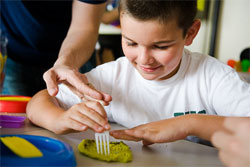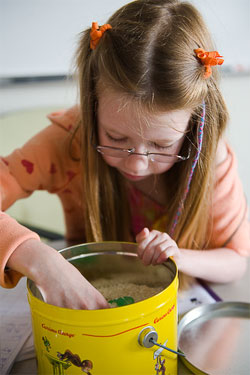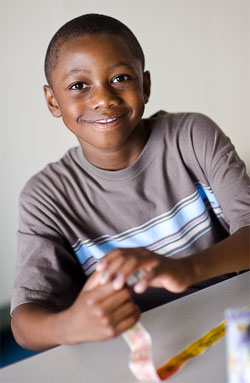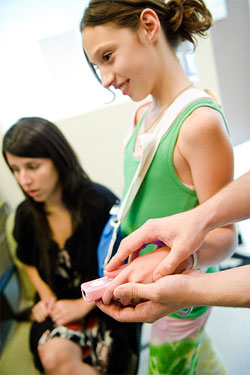TC Researchers Test New Therapy for Kids with Cerebral Palsy
“We wouldn’t be able to get them to come six hours a day unless we embedded some activities that are fun for them,” Gordon says.
Cerebral palsy is the most common childhood physical disability. According to the federal government’s Centers for Disease Control and Prevention, each year about 10,000 babies born in the
Until now, the gold standard in therapy for hemiplegia has involved restricting use of the healthy limb with a cast or soft sling or bandage (a technique that Gordon himself helped introduce and refine for cerebral palsy patients), while at the same time engaging the disabled hand on a series of repeated manual tasks of increasing complexity. Studies have shown that repeating a motion many times can improve the function of an impaired hand—sometimes in a matter of days. Researchers at TC, including Gordon, were among the pioneers of the use of constraint therapy for children.
Gordon and his team at TC’s center—which has been at the forefront of research on the complex process of how the brain directs hand function—noticed that these children have difficulty coordinating their two hands. As a result, the researches have developed a new treatment consisting of the games and exercises with the young day campers. Unlike constraint therapy, Hand-Arm Bimanual Intensive Therapy (HABIT), as Gordon calls his new technique, does not restrict the less affected hand. Instead, it embeds in the games a series of activities requiring coordinated use of both hands, while continuing to emphasize constraint therapy’s most beneficial aspect—intensive practice with the afflicted limb. In the current study, funded by the Thrasher Research Fund, Gordon is comparing the success rate of the newer, bimanual therapy with the standard constraint therapy. “Our findings thus far have been extremely encouraging,” says Gordon, who started the bimanual day camp in 2004. “They reinforce our belief that efficacy of hand rehabilitation is not dependent on the use of restrictive devices on the unaffected hand.”
Each child comes to the TC study with two goals set by the child and his or her parents. Gordon and his associates develop a treatment plan for each of them based on the goals, and use games and activities that incorporate hand and arm movements that build toward the goal. They test the motor skills of each child before and then after the camp, and, in a new avenue of inquiry, Gordon and colleagues at Columbia University’s College of Physicians and Surgeons are designing experiments to test the brain function of the children before and after bimanual therapy, to learn whether the therapy can influence the brain’s natural ability to form new connections in order to compensate for injury.
The children in Gordon’s program are physically able to perform the tasks, but they lack the necessary muscle strength or sometimes the self-confidence even to try. “A lot of it is building confidence in their ability to use both hands,” Gordon says. The confidence-building component is readily apparent, even to a lay observer. At a recent session, Lorenzo Casertano, an undergraduate at
Bimanual therapy promises rapid improvement in the everyday function of children with cerebral palsy, from learning to dress themselves to catching a ball or holding a book. The therapy, which aims at immediate improvement in coordinated use of both hands, could be applicable to people with stroke or traumatic brain injury, as well, with potential to increase their functional independence in self-care activities such as showering and dressing, as well as making them more comfortable with social interactions.
Longer term, Gordon hopes that work at TC’s Center for Cerebral Palsy Research will influence fields as diverse as neuroscience, robotic manipulation (including space exploration and remotely operated surgery) and the development of “smart” prosthetics.
For now, Gordon says he will use information mined from observing this summer’s group of campers to further modify HABIT in ways that will more deeply engage children’s families in the therapy.
“Ultimately, we want to induce meaningful changes in the lives of kids with cerebral palsy and enable them to participate in more types of physical activity,” he says. “Right now, most of these kids would probably be pulled from many activities in a normal gym class. But with the proper therapy, they might even be able to play sports.”
Published Thursday, Jul. 24, 2008



